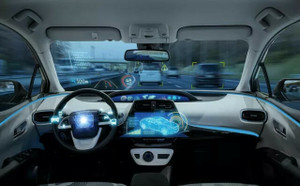Are autonomous vehicles the future of driving?
By Kijiji Autos
Your well-being remains our top priority. Please seriously consider whether in-person meetings are necessary and visit our for more information.
Despite all of the conversation, nobody knows exactly how autonomous cars will shape the way we live for the next 10, 20 or even 50 years. It is clear, though, that they will have a serious impact on how we interact with each other as well as the environment.
What exactly is an autonomous vehicle?
Autonomous vehicles, otherwise known as self-driving or “”driverless”” cars, are cars that don’t require a human driver’s intervention to safely operate. They combine several technologies, such as sensors, cameras and software, to navigate, control and drive the car.
Thanks to the attention this technology has been given in the past couple of years, there are a number of vehicles that have been developed for specific jobs and tasks that feature different levels of autonomy. Researchers often rank these levels based on a scale of 0 to 5, where 0 equals total human control and 5 represents a vehicle that is completely autonomous in all situations.
There are already examples of partially autonomous vehicles operating on city streets and highways, while many experts suggest that a vehicle with Level 4 autonomy could become available for sale within a couple of years.
History of self-driving cars
Although people have been experimenting with the idea of driverless cars since the 1920s, the first self-sufficient versions didn’t appear until 1980s. The following timeline will give a brief history to the autonomous vehicle:
1925: Houdina Radio Control debuted the first example of a driverless car with the “”American Wonder,”” a radio-controlled vehicle.
1961: Inspired by the space race, the Stanford Cart was designed—the world’s first true self-driving wheeled vehicle. The Cart was outfitted with cameras and programmed to autonomously detect and follow a solid white line on the ground.
1977: Tsukuba Mechanical Engineering in Japan produced an autonomous passenger vehicle that could recognize street markings while travelling at almost 30 km/h.
1987: German engineer Ernst Dickmanns equipped a standard sedan with many cameras and micro-processing modules to detect objects on the road. This vehicle, called VaMoRs, was capable of navigating the Autobahn at a speed of almost 100 km/h.
2004-2013: For almost a decade, the United States’ Department of Defense’s research division, DARPA, hosted a yearly competition for the general public to drive the development of autonomous vehicles forward. This challenge resulted in further developments in self-driving technology.
The future of autonomous vehicles
With further collaboration between public and private sectors, the development of autonomous vehicles has, and will only continue to grow at an impressive rate. While car manufacturers and technology companies race to be the first one to the market, governing organizations are working hard to guarantee that autonomous vehicles are safe for everyone on and off the road.
You might not be able to purchase an autonomous vehicle quite yet, but Kijiji Autos has new and nearly new options that are equipped with top-of-the-line technologies, such as Tesla Autopilot and Nissan ProPilot Assist. Start looking for your next car today.
Easily find your next ride on Kijiji Autos
Search nowThe most affordable electric cars in Canada in 2023
Looking for a budget-friendly electric car? Discover the 12 most affordable electric cars for sale in Canada on Kijiji Autos. Plus, we answer your FAQs about the costs of driving, charging and insuring an electric car.2023 Mazda 3 GX vs GS: What’s The Difference?
The 2023 Mazda 3 is a refined compact car with styling and performance that give it a upmarket feel. In this article we'll break down the differences between the Mazda 3's GS and GX trim packages to help you decide which features you'd want to take or leave, as well as what they'd cost you. Click on the listings on our Search Results page to discover the Mazda 3 GX and GS for sale near you.FWD vs AWD: What’s the Difference & What’s Right For You?
The main difference between FWD and AWD vehicles is the number of wheels their engines are able to send power to. This article will tell you everything you need to know about FWD vs. AWD and help you decide which is right for you.Coupe vs Sedan: What’s The Difference?
Coupes and sedans can both provide you with practical, fuel efficient transport that can also be fun to drive. Both body styles have their advantages and drawbacks depending on what you’re looking for in a new vehicle. In this article we’ll examine the differences between coupes and sedans and define both vehicles with examples.Is it hard to drive an SUV?
if you're stopping yourself from buying an SUV because you're afraid it's more difficult to maneuver, you'll be pleased to know that's not the case. In fact, first-time drivers will find driving an SUV no more challenging than smaller vehicles like sedans, as long as they follow a few tips outlined below.Top 11 SUVs for Winter Driving in Canada
SUVs are some of the best-suited vehicles for winter conditions with a wealth of standard and available features to help you stay in control and get where you're going when the temperature plummets below zero. Here are 11 of the top SUVs for winter driving.Sedan vs SUV: Which one is right for you?
Sedans and SUVs are two of the most popular kinds of vehicle on the market today. This article will examine the different characteristics of sedans and SUVs, highlighting the areas in which each shines and where their shortcomings lie to help you make the right choice on your next vehicle.Your Guide to Hatchback Cars in Canada
Hatchback cars are defined by their tailgate, which raises up to give access to the rear cargo area. Hatchbacks can feature two or four doors plus the tailgate, and follow what's known as a two-box design. The engine compartment at the front of the car makes up one box, with the second comprising the passenger cabin and cargo area.10 affordable convertible cars in Canada
It may be cliché, but there honestly is nothing like feeling the wind in your hair as you cruise down the highway in a convertible with the top down. Here, we explore 10 affordable convertible cars (in no particular order) to inspire you to dive into Kijiji Autos' listings and find your next vehicle.10 popular full size vans for your family or business
Whether you need to transport people or goods, a large van can be a practical choice. You might be wondering who makes full size vans or what is the best full size for family. Here are 10 of the top big vans for sale in Canada in 2022, in no particular order:









